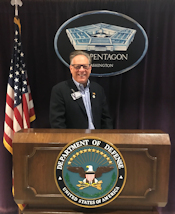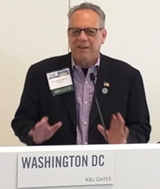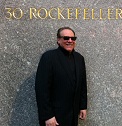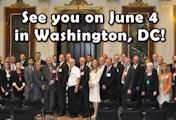Review – 9th Annual NanoBusiness Alliance Conference, Sept 27-28, Chicago, IL
Posted on October 18th, 2010 | No Comments »
The NanoBusiness Alliance hosted our 9th Annual NanoBusiness Conference on September 27-28th in Chicago, with two days of individual presentations and speaker panels plus a company showcase. Many participants stayed an additional day to network with colleagues from the Water Innovations Alliance, which co-located with the NbA for the second year.
Our conference began Monday morning September 27th with a power-packed session led off by former NbA Executive Director Sean Murdock, now CEO of Nanosonix. Sean gave his perspective on the effects of the recession on the innovation ecosystem and urged the members of our community to think about how their personal actions, as innovators and investors, can make a difference in the ultimate success of nanotechnology. He gave some historical perspective on public and private investments in nanotechnology, reminding the audience that we are still working in a very young field. He noted that this fact makes us especially vulnerable to the effects of the broad decrease in venture capital investments and other private financing which began two years ago. Public funds and public-private partnerships are thus more important than ever. Murdock said that an increase in the overall scale of investment in commercialization activities from U.S. source is essential in order to effectively capture the value of the extensive taxpayer investment in nanotechnology.
The second presenter in the opening session was Nanosphere President and CEO William Moffitt. Bill noted we were meeting amidst the very active and positive Chicago nanotech community. Nanosphere and their neighbors are leading innovators in applying nanotechnology to develop new medical diagnostics and therapeutics. He also noted that the transition from lab science to commercial technology often takes decades, but showed that Nanosphere is well on the way to commercializing the conjugated gold nanoparticles that Chad Mirkin of Northwestern University first developed in 1997. Nanosphere’s Verigene system based on this technology is FDA approved for several in vitro tests, and the company continues to expand that product line. Offering rapid, highly selective, amplification-free testing of genetic materials, Moffitt believes this technology will eventually replace the two major biomedical breakthroughs of the last 40 years – immunoassays and PCR-based genetic testing. Nanosphere’s test for troponin, for example – a protein complex released into the blood stream during a heart attack – is far more sensitive than the conventional assays commonly used in hospital emergency rooms. These kinds of tests will first be used for medical conditions that are both widespread and expensive to treat. As their cost comes down into the $10 range, however, many additional indications will become attractive.
Intel’s Government Programs Manager, George Thompson, followed with his own take on where nanotechnology fits in the story of American innovation. Thompson, who manages Government Programs for the semiconductor manufacturer, emphasized that innovation (as opposed to invention) takes place in a context that depends heavily on culture. While the U.S. reputation for innovation is rightfully strong, he noted that our science and technology culture has changed significantly in the days since, for example, the semiconductor revolution began. We are still the innovation leaders by most measures, but our lead is disappearing. When the transistor was first developed, Bell Labs (as the research arm of a regulated monopoly) functioned almost as a federal technology R&D center. Department of Defense investments and the in-house relationship with Western Electric brought the transistor through the valley of death. Thompson noted that his industry’s ability to continue innovating rapidly – following what we all know is Moore’s Law – is based on an unusual property of transistors: they get better as they get smaller. He urged us to think about where else nanotechnology may enable synergies that allow for multiple generations of product improvements. George gave several examples illustrating the previous speakers’ remarks that we should be patient given the typical 15-year-plus timescale for technology development and acceptance, and then refined that view with two observations: 1) our accomplishments to date are by no means insubstantial, and 2) long-term development calls for a strategic, long-term view. In the United States it is rare to find that view outside of government, but public-private partnerships offer industry a good mechanism for participating in extended development. Right now, we are net exporters in only a few industries: raw materials, airplanes, entertainment, and services. It will take planning to change this, especially given the coordinated efforts taking place in other countries.
Illinois Congressman Daniel Lipinski capped off our opening session with remarks about the economy, the political climate in Washington, and how nanotechnology plays into his hopes for his own district. As most of our readers know, Congressman Lipinski is a member of the House Science Committee and a long-time supporter of the nanotechnology community, and was an important force in moving reauthorization of the National Nanotechnology Initiative through the House. Unfortunately, he told us, we’re unlikely to see imminent action from the Senate on NNI reauthorization or the Small Business Innovation programs (SBIR & STTR). In fact, some of his congressional colleagues are opposed to any Federal funding for commercialization activities. But he promised to continue to push for these bills and other mechanisms to help turn the last decade’s $12B Federal investment in nanotechnology into successful companies providing new American jobs. As the representative of an urban and middle class suburban district with a long manufacturing tradition, Congressman Lipinski is counting on us to help reinvigorate his local economy with products built here, not in China or Japan. You’ll find the full text of Congressman Lipinski’s address online at http://bit.ly/lskiNBA2010.
Following the plenary session, attendees had two tracks from which to choose. Dave Arthur of SouthWest Nanotechnologies and Michael Lefenfeld of SiGNa Technologies led off the Innovations in Nanotechnology track with updates on their company’s stories, after which Glenn Killoren (Barnes & Thornburg) led a panel entitled “Recent Trends in Buying & Selling Your Nanotech Company”. Mike Pellegrino (Pellegrino & Associates), Curt W. Hidde (Barnes & Thornburg), and Thomas Churchwell (Midwest Venture Partners LLC) rounded out the discussion.
At our EH&S track, Lynn Bergeson, Partner, Bergeson & Campbell, moderated a panel which reviewed regulatory and policy issues nanotechnology companies face. Rosalind Volpe of the Silver Nanotechnology Working Group updated NbA members on the progress her group has made in working with the EPA to clarify the status of nanosilver under the Federal Insecticide, Fungicide and Rodenticide Act since she first addressed us during last March’s Alliance meeting in Washington, DC. Evonik’s Shaun Clancy, who has been an active participant in ISO and OECD nanotechnology groups, updated us on international standards activities related to nanomaterials safety, as well as work among U.S. chemical trade associations. Kenneth Moss from the EPA’s Office of Pollution Prevention and Toxics discussed the agency’s current thinking regarding nanomaterials under the Toxic Substances Control Act, noting many similarities to the approach the agency took with biotechnology. Nina Horne, a City Commissioner in Oakland, CA and a delegate to the OECD’s Working Party on Manufactured Nanomaterials, has been closely monitoring the California Department of Toxic Substances Control work on nanotechnology under its green chemistry initiative. She urged all nanomaterials manufacturers to look carefully at the California calls for data and proposed requirements, which could be much more prescriptive than what other states and the Federal EPA are doing. Philip Lippel, a member of our advisory board and a consultant on nanoscience and emerging technologies, summed up the morning EHS session with comments on how these developing issues fit into the overall picture of regulation and public acceptance for nanomaterials and nanotechnology more generally. The group reconvened later in the day for a freewheeling discussion with interested attendees regarding the developing regulatory landscape and opportunities for NanoBusiness Alliance members to work together in this area. Lynn Bergeson invited all interested parties to contact the EHS committee members to discuss how the NbA can promote product safety and ensure that companies have clear paths for complying with applicable regulations.
Two distinguished speakers addressed the conference during lunch – Clayton Teague, Director of the National Nanotechnology Coordination Office, and George Scalise, President of the Semiconductor Industry Association. Dr. Teague spoke of the high priority in the Office of Science and Technology Policy for research related to climate change and clean, sustainable energy. He urged everyone to look at Presidential Science Advisor John Holdren’s recent Kavli Prize Symposium speech on the subject, available at http://bit.ly/JHoldren_Kavli. Then he thanked NbA members for their participation in the strategic plan review process for the National Nanotechnology Initiative and said the updated strategic plan is on target for release in late December. There will be no substantive changes to the overall NNI goals, but the agencies are working hard to include much more specific objectives and milestones pursuant to those goals. Mr. Scalise followed with a presentation that emphasized the importance of sustained R&D to the semiconductor industry as it seeks a new nanoscale switch to replace the CMOS transistor. As detailed in the International Technology Roadmap for Semiconductors, CMOS will reach its ultimate size and performance limits in just a few more generations, sometime around 2015. The Nanoelectronics Research Initiative, in which SIA partners with NSF and NIST, is intended to ensure that the U.S. maintains its leadership as the semiconductor industry discovers and develops new technologies to extend Moore’s Law beyond the CMOS era. As such, it is perhaps the premiere example of the kind of public-private partnership so many of our speakers touted as essential to the successful commercialization of America’s nanotechnology know-how.
After lunch, the EHS track continued with an extension of the morning panel discussion, followed by Don Ewert’s (OSO BioPharmaceuticals) presentation on how nanoEHS issues are handled in an industry with well-established industrial toxicology practices. Meanwhile the commercialization track continued, starting with an Intellectual Property panel moderated by Dr. J. Steven Rutt (Foley & Lardner LLP) and featuring Neil Kane (Advanced Diamond Technologies), Stephen G. Wasko (Wasko Associates), Sven Riethmueller (Foley & Lardner LLP), Dr. Jeffrey R. Lomprey (Foley & Lardner LLP) and Mark Kaczor (University of Illinois at Urbana-Champaign). They discussed changes in patent law and policy that affect nanotechnology along with other emerging technologies. They noted a wide variation in the sophistication among university licensing offices (which are so often involved with nanotech startups), noting that some give broader licenses than they should to companies with the ability to commercialize only in limited areas. We are beginning to see government march-in rights asserted in some of these cases, as allowed under Bayh-Dole to ensure that government-funded research is widely commercialized.
Doug Jamison and Alexei A. Andreev, both of Harris & Harris, followed with the first of several discussions of the venture capital climate. They shared their perspectives on ten years of nanotechnology investing, including H&H’s investments in 31 nanotech or microsystems companies. Alexei noted that people tend to overestimate the short-term impacts of a new technology and underestimate its long-term impacts. H&H itself was guilty of this, he said, in terms of underestimating the necessary capital investments and development timescales. On the other hand, they are seeing a higher percentage of companies survive and slowly build revenues than they originally expected. Harris & Harris feels that small VC firms, and a new breed of serial investors he calls superangels, are carving out a distinct role from larger VC firms. Superangels are particularly well suited for Web 2.0 companies, for example, where there is no visibility into the end market but one can quickly and cheaply build a first product to assess it. Large firms are drawn to industries like biotech, where the potential market and costs of competing technologies are easier to predict but the development risks are very high. H&H continues to feel that nanotechnology is a good fit with their middle ground investment strategy, which is to bet not just on cool technologies but on companies with well-defined products and identified niche entries to the market. Doug expanded on these ideas in the penultimate plenary session of the day, giving a detailed description of Harris & Harris’ portfolio of companies in cleantech, electronics, healthcare, and other industries. He divides these investments into three development stages, and noted that interested Alliance members can easily track their progress through these stages via the company’s 10K filings. He concluded by saying it is unclear how the VC community will develop in the next few years. The well-known paucity of early stage deals recently may be partially alleviated by the rise of superangels, for example, but so far they have operated almost exclusively in the internet arena, plus a few cleantech deals.
Lux Research’s Jurron Bradley closed out the first day’s talks with a summary of Lux’s onboard intelligence regarding the nanotechnology community. He noted that government and corporate sponsorship for nanotechnology R&D each amounted to about $8.5B worldwide in 2009, with important U.S. and non-U.S. investments in both categories. Approximately $500M was added to USG funding through the American Reinvestment and Recovery Act. On the VC side, 6 of the top ten deals were in healthcare, with energy and environmental technologies also remaining strong despite the overall 42% decrease in VC funding vs. 2008. Nano companies received VC funding for improved batteries and for filtration products (both water and air). Lux sees the VC pie as stable or shrinking slightly in the next two to three years. Lux maps nano R&D on a two-dimensional Innovation Grid, with Business Execution and Technical Value as the axes. When they apply this methodology on a country-by-country basis, the U.S. remains at the top in technical value but is in the middle of the pack on business activity/execution, crossing over into what they call the ivory tower quadrant. Japan and Germany, in contrast, have high scores on both axes, while Singapore’s targeted electronics R&D makes them a good example of a niche player with excellent execution in limited fields. One area where Russia excels is in workforce training, but they do a poor job of utilizing their highly educated workers. In contrast, the U.S. falls short of its peers in producing degreed scientists and engineers, a weakness which must be addressed if we are to move squarely into the dominant sector of the Lux Innovation Grid.
On day two of the conference, the plenary sessions were shared with the Water Innovations Alliance. The morning session gave NbA members a chance to hear several big players in the water industry talk about how their companies innovate, with presentations from Don Thompson, President of the Oil Sands Developers Group, representing companies active in the Athabasca oil sands region of Alberta, Canada; William F. Wescott Ph.D., VP for Innovation-Americas at French water giant Veolia Environnement; and Mark LeChevallier, PhD, Director of Innovation & Environmental Stewardship for American Water, the largest investor-owned water and wastewater utility company in the United States. After splitting off from our water colleagues, we heard from Jim Hussey, CEO of one of the Chicago area’s leading nanotech companies, NanoInk. Jim described the potential for using nanotechnology-based testing to develop test data as input to the regulatory process for nanomaterials. Jim emphasized that alternative test methods could reduce the time and cost of testing while reducing the reliance on animal-based methods. He called for support for a correlative testing program which would validate these new testing methods. The morning session concluded with an update on the regulatory environment from Thompson and Hine lawyers Fern O’Brian and Thomas Feher. They reviewed the EPA’s methodology for addressing nanomaterials under various sections of the TSCA and FIFRA laws, including possible effects of proposed changes to TSCA and the evolving regulation of cosmetics under current FDA authorities. They noted that the TSCA reform bill introduced in the House of Representatives shifts the burden of proving safety to the manufacturer, for example by requiring them to show that aggregate and cumulative exposure to a substance or mixture results in no harm. Meanwhile there is an evolving body of sometimes conflicting scientific and medical research regarding the safety of nanotechnology, and a tendency on the part of the public to lump all nano together in this respect. These all add up to a legal environment in which companies must consider the potential for design defect claims, latent undetected exposure, and complex causation scenarios leading to highly individualized case-by-case litigation. A company can limit its risk by assessing the safety and environmental impacts of its products early on, keeping abreast of evolving science and medical knowledge, tracking and complying with evolving standards and practices, and developing strong internal policies and procedures regarding EHS. Furthermore, they should monitor post-sale product complaints and adverse event reports and respond to them appropriately, remembering that regulation alone does not eliminate potential liability – a company’s conduct must be reasonable in light of all circumstances.
Tuesday’s luncheon keynote brought us back together with the water group to hear Deputy Assistant EPA Administrator Michael Shapiro review the condition of our surface and drinking waters as we approach the 40th anniversary of the Clean Water Act. He reminded us that the CWA and the Safe Drinking Water Act, enacted a few years later, had been instrumental in bringing major pollution sources under control and making secondary treatment of wastewater nearly universal, but noted that we add more waterways to the impaired list each year than we remediate. Many native fresh water species are in danger of extinction, and pollutants such as hormone disruptors are widely detected yet poorly understood. As our population increases and land use changes, we are in danger of losing many of the gains of the last 4 decades. The resolution of this dilemma will require new legal approaches as well as new technology for real-time monitoring and for remediation. The EPA is now taking public comment on how to approach new contaminants threatening our drinking water. Their actions to date have more or less been on an individual pollutant basis, but with a growing backlog they are now considering efforts to group substances either by chemical and biological characteristics or by treatability.
After lunch we again had two nano tracks, the first focused on nanomedicine and the second on transitioning from R&D to commercial production. Mostafa Analoui, Head of Healthcare and Lifesciences for Livingston Securities, led the nanomedicine track. Dr. Analoui noted that the economic turndown had broadened the valley of death, but pointed to the recently announced $2.9B acquisition of Abraxis Bioscience by Celgene as a milestone for first-generation nanopharmaceuticals. Panelist Piotr Grodzinski, the director of the National Cancer Institute’s Alliance for Nanotechnology in Cancer, described the Alliance’s work supporting academic and industry researchers, including the innovative collaboration with NIST and the FDA to help them transition therapeutics into clinical settings via the Nanotechnology Characterization Laboratory. He updated us on the progress of several liposomal or polymeric nanopharmaceuticals through the clinical trial process, and noted the important opportunity to utilize nanoscale delivery mechanisms for difficult-to-deliver molecules such as siRNAs. Sarah Lee of Baxter Healthcare and Anil Diwan of NanoViricides then each described their company’s nanotechnologies. Baxter is working on reformulations of several compounds as nanoscale solids, coatings, or suspensions; Dr. Lee used their work on improved delivery of paclitaxel to ovarian tumors as a case study. NanoViricides has developed a platform technology which mimics cells from the virus’s perspective. Viruses try to attack the company’s nanomicelles, but they unfold, encapsulating and deactivating the virus. The company has the potential to develop specific nanoviricides targeting Dengue, Marburg, Ebola, HIV, or many other viruses and is also developing a technology which would allow field development of a product for rapid response to novel viruses. The company has recently raised $12M which will enable expansion of their testing program. Ioannis Tomazos, CEO of Biorasis was the next speaker. Dr. Tomazos expects the company’s implanted sensors, which use nanogels for biocompatibility and communicate with the external world via wireless transducers, to find their first successes in animal use, for accelerated drug development. Once they have developed and validated accuracy standards for human use, Biorasis foresees application as a continuous glucose monitor. The final three nanomedicine panelists were Winton Gibbons, Sr. Vice President of Business Development for Nanosphere; Percy Van Crocker, Jr, Vice President, Commercial Development, AuraSense, LLC; and Dr. Rangaramanujam M. Kannan, Professor of Chemical Engineering and Materials Science, and Biomedical Engineering, Wayne State University. Gibbons elaborated on Nanosphere’s nucleic acid detection and protein diagnostics technologies, previously discussed on Monday by Bill Moffitt. Mr. Crocker discussed AuraSense’s products, also originating from the conjugated gold nanoparticle technology developed at Northwestern University, for therapeutic use (gene regulation, synthetic HDL) and for assaying genetic material within cells. Professor Kannan discussed his group’s work at Wayne State using nanodevices based on dendritic polymers conjugated to drugs and imaging agents.
Meanwhile, two successive panels discussed issues regarding how to cross the commercialization gap. Skip Rung of the Oregon Nano and Microelectronics Institute led the first panel, in which several Oregon companies joined ONAMI Gap Fund Manager, Jay Lindquist, to discuss their state’s innovation ecosystem. Panelists included Walt Weyler of Crystal Clear Technologies; Mark Owen of Puralytics, and Mike Brown of Zaps Technologies. The second panel, moderated by Todd G. Vare (Barnes & Thornburg LLP) and featuring Jon Belkowitz (Intelligent Concrete, LLC) and Craig Bandes, (Pixelligent Technologies) emphasized the value of building strong relationships with government entities willing and able to be first customers.
Our conference concluded with two very different but equally inspiring scheduled talks by superstars of the water community, plus a bonus address by a distinguished visitor. Professor Mark Shannon of the University of Illinois talked about the fomenting revolution in water, discussing a myriad of technical solutions to the wide variety of supply and treatment issues around the world. NbA members familiar with Mark’s work won’t be surprised to hear that many of these solutions involve nanotechnology. Mark was followed by a special guest who became available to speak after our programs went to press, Vepo Ragayer of the International Finance Corporation. As a private finance group operating within the World Bank Group, the IFC aggressively funds programs in the developing world that are focused on climate change and environmental sustainability. They will provide about $20B in debt and equity financing during FY2010, of which about $1B will go to water infrastructure projects that will impact an estimated 35 million people. They hope to triple the size of the water program in the next three years. The conference closed with an inspiring presentation by Explorer & Aquatic Environmentalist, Fabien Cousteau, who is carrying on in his grandfather’s tradition to make the public aware of the fragile beauty of oceans.
I would like to thank our attendees, speakers and sponsors who contributed to our success in Chicago.
Regards,
Vincent Caprio “Serving the Nanotechnology Community for Over a Decade”
Executive Director
NanoBusinenss Alliance
203-733-1949
vincentcaprio@nynanobusiness.org
www.nanobusiness2010.com
www.vincentcaprio.org




